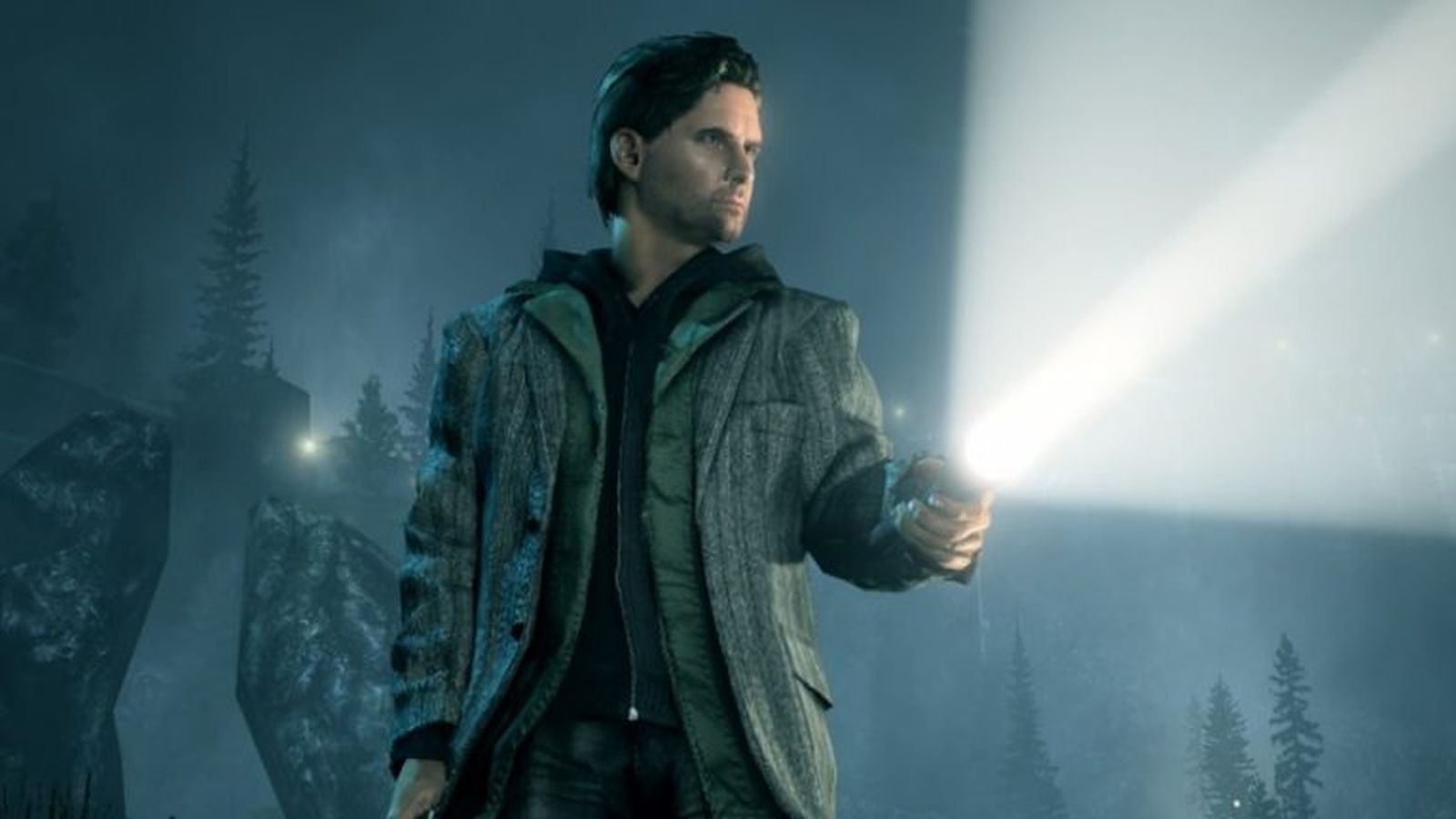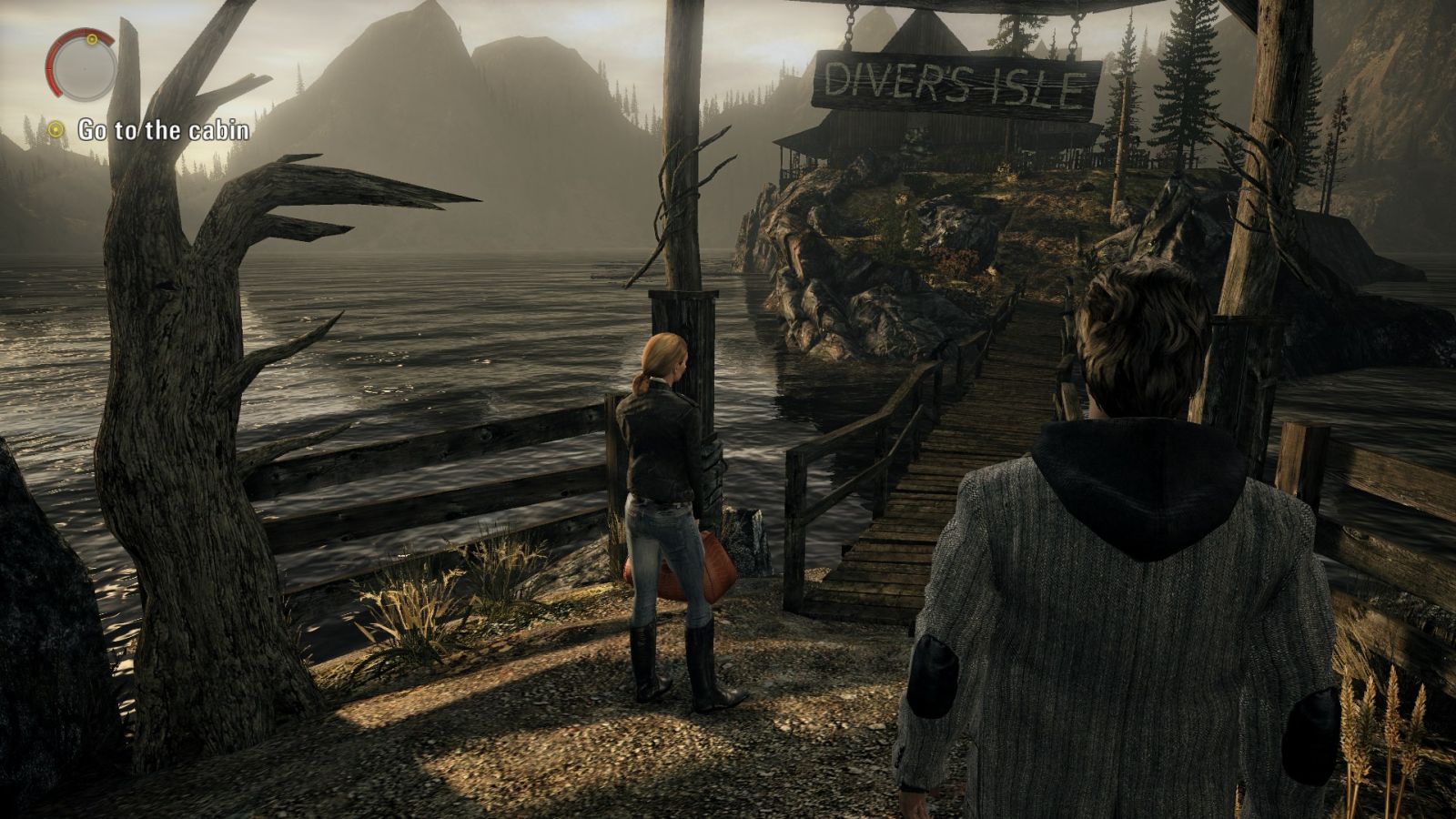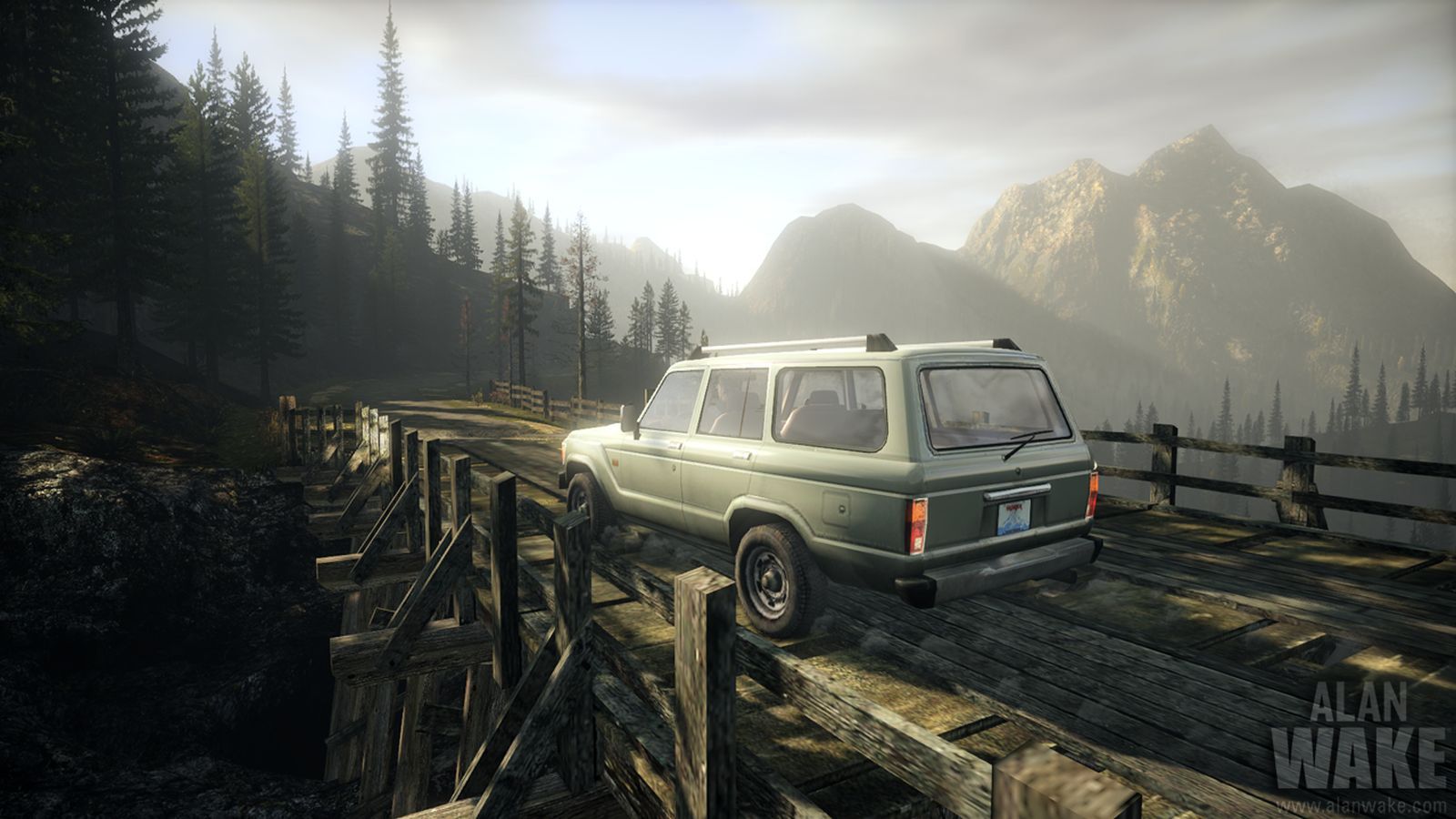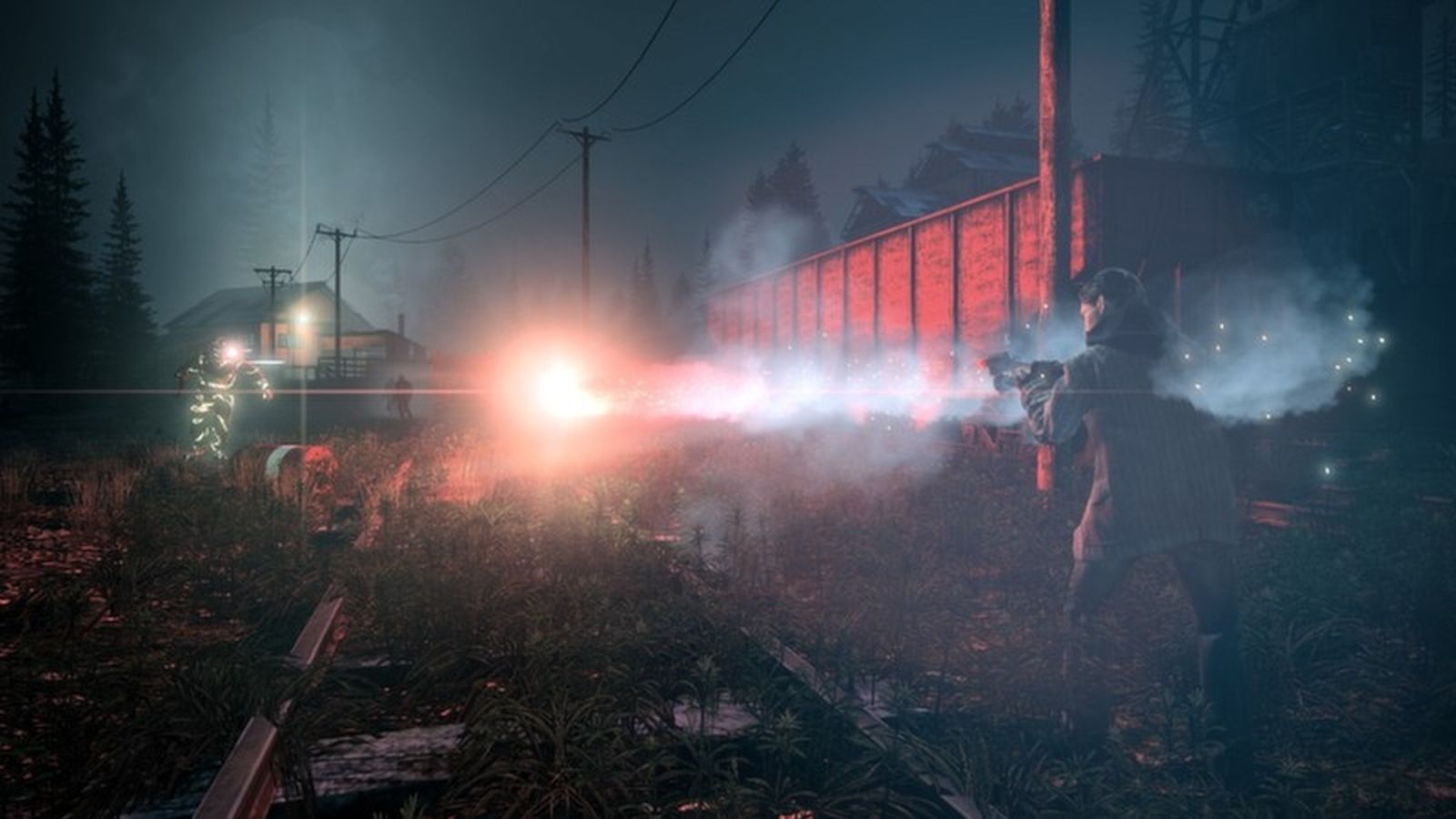At E3 2005, Finnish developer Remedy (of Max Payne fame) pulled me aside for a behind-closed-doors view of a freshly-announced title called Alan Wake. While there was little in the way of actual gameplay, the technology they showcased was beyond anything I’d seen to date. Stunning visuals, day and night cycles, and very realistic lighting work were just a few of the highlights for Alan Wake. After the show the game would go dark for years before resurfacing for a Spring 2010 release. After a great deal of waiting and speculation, we finally have our hands on Alan Wake.
Alan Wake opens with a writer by the same name telling us the audience about a nightmare that had started this story. He was driving along a road when a pedestrian appeared out of nowhere, being struck down by Wake’s car. His car dead, Wake steps out to see if the man was ok and finds that the corpse of the man has disappeared. Making his way towards a lighthouse in the distance, Alan glances back to see the man enveloped in a sort of shadow, spewing nonsense at him and chasing him with an axe.
Alan wakes from his nightmare in the car with his wife. They were on a ferry to a place called Bright Falls for a vacation. His wife Alice and his agent Barry believed that the beautiful Oregon landscape of trees and beauty would be enough to break his writers block and put him on the path to his next book. As they make their way through the typical Northwestern town, Wake realizes that his popularity reaches even here. Retreating away from his star-struck fans, they make their way to their secluded cabin. Wake and his wife get into a heated argument and he storms out on her. As the world around their lakeside cabin suddenly go dark, the world of Alan Wake takes a sudden spin towards the surreal.
The folks at Remedy stated that they were inspired by Twin Peaks, Lost, The X-Files, and the works of Stephen King as their inspiration, but having completed Alan Wake, I can assure you that those inspirations are just scratching the surface. The game has heavy elements of The Twilight Zone, In The Mouth of Madness, and a very dark and twisted NeverEnding Story as well. Most survival horror games serve as a fine example of C-rated shoddy writing riddled with cheap scares and loud noises. Alan Wake will go down as a compelling story wrapped around a legitimate nightmare-inducing horror script. I will do my best to try to keep this review spoiler free as much as possible, and with good reason – Alan Wake may be the best written story you’ll play all year.
Graphically, Alan Wake was an absolute impossibility on any home console in 2005. With the Xbox 360, there is enough graphic power to bring Wake’s world to life. Much of the game is spent in the dark, but this isn’t a Resident Evil knockoff – the world looks like what you’d see in a forest illuminated by stars and the moon, and not just pitch black like Doom 3. There is a bluish hue to the world, and the forest is absolutely choked full of foliage. Full size trees, bushes, plants, leaves, signs, debris, and more sway in the wind, providing a shocking amount of ambush points for the creatures in this game. It isn’t just black, it’s darkness the way you and I would perceive it in the real world. You’ll spend a fair amount of time in the town of Bright Falls, and it is well populated, both with people and things to see. The town is excited about their annual Deerfest celebration, and it is decorated accordingly. Somehow the city feels alive, not just filled with pre-placed objects. While it isn’t the sandbox city that was initially planned, it feels focused without ever putting your feet on rails.
The incredible lighting engine I mentioned above is the heart of the game. Day and night cycles cast absolutely perfect shadows. Most games do such a weak job with shadows, putting simple circles under the feet of the protagonist. Alan Wake was built around the concepts of light and dark, and it shows. Your flashlight has small concentric circle distortions from the lens, and the light realistically bends across objects. It pales, however, in comparison to when the real fireworks start.
The creatures that pursue you in this game are called Taken. They are guided by a malevolent force called The Darkness for reasons unknown until almost the very end of the game. When Taken are in the area, you’ll occasionally get a slow motion view of them sneaking up on you seconds before they cut into your flesh with hooks, axes, and various other makeshift weapons. As your world gets even darker, the forest will sway violently with an otherworldly malevolence. Dark shadows rip through the area, obscuring your vision. It is almost as if the night sky above you is moving in fast forward, the shadows cutting at your psyche. It is unlike any lighting effect I’ve seen in any game or movie, and it creates incredible atmosphere.
There is a hitch to this level of visual fidelity – there are a few points in the game where framerate suffers a bit, but it was always fleeting and infrequent. There were also a few moments where character voices didn’t match the lip synch, breaking immersion a little bit. These are such minor trivialities, but they do bear mentioning.
The Taken themselves are a visual and auditory treat. These twisted creatures are enveloped by darkness, the effect above dancing over their bodies on a smaller scale. They retain some portion of their previous selves, spewing crazy nonsense as they duck in and out of the shadows, closing in on you. Many times I found myself jumping in my seat as the Taken surrounded me, hacking me to death.
Unlike most survival horror titles, you aren’t given the usual knife/pistol/shotgun/machine gun/grenades weapon progression. The best weapon against the creatures in the game is a simple flashlight. They abhor the light, and when backed by a pistol, shotgun, or simple flare gun, you have the tools necessary to beat them back into the shadows.
Thankfully, and also unlike most survival horror games, you aren’t hindered by the control scheme in Alan Wake. You are able to walk and shoot at the same time, and you can get from A to B without looking like you have a broom handle down your spine. You can carry four weapons and two types of incendiary devices (flares and flash grenades), but you’ll also be given the opportunity to trade out your shotgun for a rifle, or your little flashlight for a larger model. You never feel like you are ‘powerful’, and that sort of constant disadvantage plays perfectly to the tone of the game. While Alan Wake is primarily a horror/adventure title, you won’t feel like Alan can’t defend himself – just not any better than you’d expect out of any other ‘average Joe’.
Though most gamers aren’t aware of them, there are awards for the audio portions of games, and Alan Wake deserves to win one or two. Alan narrates a great deal of the game, including the manuscript pages that you’ll collect throughout the story. Matthew Porretta does a great job bringing the protagonist to life. Similarly, Barry is a hoot and provides a little levity to the otherwise dark content of the title. The Sherriff hands in a somewhat uneven performance, but you’ll quickly forget that in favor of the incredible sound effect and orchestral work in the title. The screeching otherworldly sound you’ll hear when you train your light on various dark objects in the game is the sort of sound work you’d hear in any great horror flick. The buildup music just prior to an attack does a great job of setting the tone, and the music chosen for the moments between Episodes (there are 6 in the game, and DLC as well as sequels are planned) reminds me of the poignant credit sequences you might hear after an episode of True Blood.
For the collectors amongst us, there are 100 Coffee Thermoses to find, 13 TV Shows to watch, 12 Radio Shows to listen to, and a smattering of hidden caches and signs to find. There are over 100 manuscript pages to find, some of which only discoverable on the highest difficulty levels, which provide a great deal of the compelling storyline. Not since Batman Arkham Asylum have I felt this compelled to find every single thing in the game. All told, you can complete all 6 of the Episodes of Alan Wake in roughly 10 to 12 hours, but it’ll take you far longer to discover everything in the game. Every copy of the game will ship with a token for the first DLC Episode, so expect more Alan Wake after you complete the content on the disc.
Ron Burke is the Editor in Chief for Gaming Trend. Currently living in Fort Worth, Texas, Ron is an old-school gamer who enjoys CRPGs, action/adventure, platformers, music games, and has recently gotten into tabletop gaming.
Ron is also a fourth degree black belt, with a Master's rank in Matsumura Seito Shōrin-ryū, Moo Duk Kwan Tang Soo Do, Universal Tang Soo Do Alliance, and International Tang Soo Do Federation. He also holds ranks in several other styles in his search to be a well-rounded fighter.
Ron has been married to Gaming Trend Editor, Laura Burke, for 28 years. They have three dogs - Pazuzu (Irish Terrier), Atë, and Calliope (both Australian Kelpie/Pit Bull mixes), and an Axolotl named Dagon!

Alan Wake is definitely art, and is well written enough to keep my wife and I on the edge of our seats from beginning to end. If I can admit something, and give Alan Wake the biggest compliment I can bestow, I’d tell you that I had a nightmare about the game the night after I completed it. No horror game has ever managed that feat or even come close. It may have taken them five years to kick it out of the door, but Remedy has created a masterpiece.
PROS
- Lighting engine is the best I’ve ever seen
- Environments are lush and visually stunning
- Compelling and expertly written storyline
- Genuinely frightening
CONS
- Lip synch issues
- Occasional framerate issues







 Buy Now
Buy Now
 Buy Now
Buy Now
 Buy Now
Buy Now
 Buy Now
Buy Now
 Buy Now
Buy Now
 Buy Now
Buy Now















